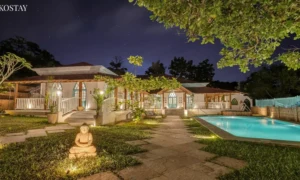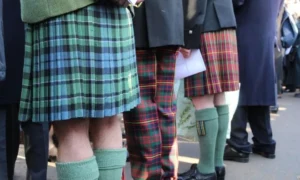Kedarnath Temple, meaning ‘temple of the God of the field’, is one of the twelve jyotirlingas or holiest Shiva shrines. It lies on the Garhwal Himalayan range near the Mandakini river in Uttarakhand, India. As the weather conditions are quite extreme here, the temple is open to the public only between the months of April and November. During the winters, the idol of the main deity is taken to Ukhimath and worshipped there for the next six months. Kedarnath is a homogeneous form of Shiva.
The temple has no direct road access. It is a 22 km uphill trek from Gaurikund. One can avail of pony, mule, and manchan service to reach the temple. As per Hindu legends, the Pandavas built the temple initially. The Pandavas supposedly pleased Shiva by doing penance in Kedarnath. The Kedarnath Temple is one of the 4 major sites in the Chota Char Dham pilgrimage of the Northern Himalayas.
It is also the first of the Panch Kedar pilgrimage sites. Highest among the 12 Jyotirlingas at an altitude of 3,580mts, it is one of the 275 Paadal Petra Sthalams praised in the Tamil Shaivite text, Tevaram, written during the 6th and 7th centuries by 63 saints called Nayanars. Thirugnanasambandar, Appar, Sundarar, and Sekkizhar have written about the temple in their Tevaram texts. Kedarnath is around 221 km from Rishikesh. Kedarnath is a very important pilgrimage for Hindus and spiritual seekers. The Mandakini River flowing nearby, breath-taking natural vistas, snow-clad mountains, rhododendron forests, and serene environment add to the temple’s attractions.
Maha Shivaratri is one of the important festivals at the temple.
During the 2013 flash floods, Kedarnath was severely affected. The temple and its surrounding areas, as well as Kedarnath town, suffered great damage. However, the temple structure was not greatly damaged, except for a few cracks on one side of the four walls.
Kedarnath town is in the Garhwal Himalayas. The town lies near the Chorabari glacier, which supplies the Mandakini River. This ancient temple is famous for its exquisite architecture. Very large and evenly shaped grey stone slabs have been used in the construction. There is a conical rock formation inside the temple, which people revere as Shiva in his “Sadashiva” form. Behind the temple stands the Kedar Dome, Kedarnath Peak, and other Himalayan peaks.
Legend behind Kedarnath Temple
Kedar Khand is the historical name of this place. According to legend, the Pandavas, after defeating the Kauravas, suffered pangs of guilt for having killed so many people in the Kurukshetra war and sought redemption for their sins from Lord Shiva, as advised by Krishna. Shiva kept giving them the slip and took refuge at Kedarnath, taking the form of a bull. It was in Guptkashi that they finally found Shiva. But Bheema identified Shiva and chased him. He managed to catch hold of his tail while the rest of the body vanished.
Shiva dived into the ground but left his hump above the earth’s surface at Kedarnath. The remaining part of Shiva appeared at 4 other places, where devotees worship them as his manifestations. Shiva’s arms appeared at Tungnath, his face at Rudranath, his belly at Madmaheshwar, and his hair at Kalpeshwar. All these shrines together, including Kedarnath, form the Panch Kedar pilgrimage circuit.
History of Kedarnath Temple
Kedarnath was supposedly built in the 8th century AD by Adi Shankaracharya at a site adjacent to a spot where the Pandavas supposedly constructed a temple. One can see the ruins of a monument here, which is supposedly where Adi Shankara attained Mahasamadhi. By the 12th century, Kedarnath was a major pilgrimage center. It finds mention in Kritya-kalpataru written by Bhatta Lakshmidhara, the Gahadavala minister. Kedarnath Teerth Purohits and their ancestors have been worshipping the Shiva lingam at the temple since the time of Nara-Narayana and Daksh Prajapati. King Janamejaya, the grandson of the Pandavas, gave them the right to worship at this temple and donated the whole Kedar region to them.
The English mountaineer Eric Shipton (1926) claims that hundreds of years ago, one priest used to perform Pooja services at both the Kedarnath and Badrinath temples, travelling between the two places every day.
Architecture of Kedarnath Temple
The Shiva Lingam is more triangular in shape. It has a pedestal that is 3.6 m (12 ft) in circumference and 3.6 m (12 ft) high. A small pillared hall in front of the temple has images of Parvati and of the five Pandava princes. The first hall inside the Temple contains statues of the five Pandavas, Krishna, Nandi, and Virabhadra, a guard of Shiva. There are statues of Draupadi and other deities in the main hall. One unusual aspect is that a man’s head is carved in the triangular stone lingam. Such a head can be seen carved in another temple nearby. It stands on the site where the marriage of Shiva and Parvati was supposedly held. Behind the temple is Adi Shankara’s samādhi mandir.
Benefits of Worshipping at Kedarnath Temple
It bestows longevity.
It can grant Moksha or liberation from the birth-death cycle.
It removes the fear of death and protects one from untimely death.
It eradicates all sins.
It bestows happiness, peace, harmony, and wealth.
It can cure mental and physical ailments.
How to Reach Kedarnath Temple
By Air:
The nearest airport is Jolly Grant Airport, Dehradun, which is approximately 239 km away. One can get a taxi or take a bus from the airport to reach Kedarnath.
By Train:
Haridwar railway station is the nearest, around 241 km away. From the station, you can take a bus or a taxi to the temple.
By Road:
Kedarnath is well-connected by road to key cities like Delhi, Rishikesh, Haridwar, and Dehradun. Taxis and buses are available to reach Kedarnath. Haridwar to Kedarnath is around 240 km.
By Helicopter:
One can also take a helicopter from Phata, Sersi, or Guptkashi. The helicopter service can be booked offline or online. It is available from May to October.
Temple Timings The opening date and time of the temple depends on the date of Akshaya Tritiya and is declared on Maha Shivaratri. The priests in Ukhimath’s Omkareshwar Temple fix the opening date after seeing the Panchang. The doors of the holy temple are closed for the winter now. They will reopen in April-May 2024. The temple will be closed 2 days after Diwali, when Bhai Dooj is celebrated.







































